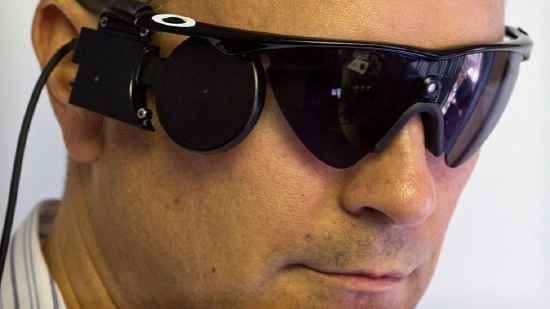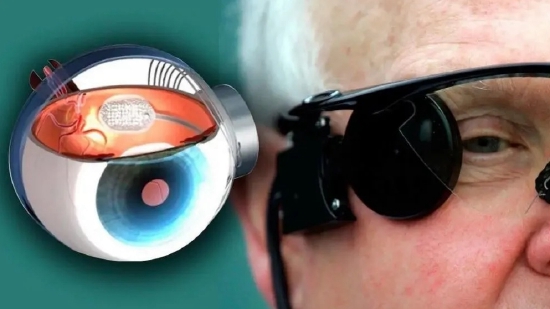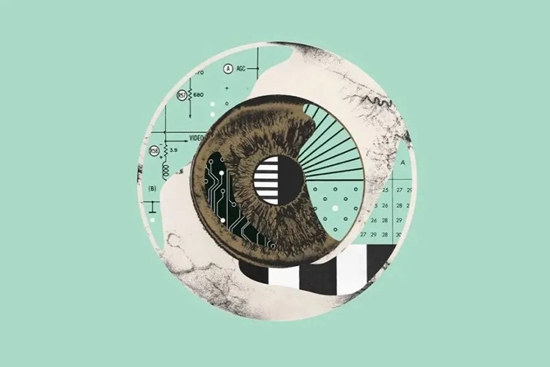澳大利亚的科学家们花了 3 个月,通过手术给一小群绵羊的视网膜后植入了仿生眼,这群羊从此有了超出它们所能见的“异常敏锐的视力”。这些羊是医学实验的一部分,最终目的是希望能帮助患某些类型失明症的人恢复视力。

Bionic eye tech aims to help blind people see
Once upon a time there were some unusual Australian sheep, with exceptionally sharp eyesight.
有一些不寻常的澳大利亚羊,它们的眼力异常敏锐。
The small flock spent three months last year with bionic, artificial eyes, surgically implanted behind their retinas.
去年,研究人员花了三个月时间,为这群澳大利亚羊做了外科手术,在它们的视网膜后植入人工仿生眼。
These sheep were part of a medical trial that aims to ultimately help people with some types of blindness to be able to see.
这些羊是医学实验的一部分,最终目的是希望能帮助患某些类型失明症的人恢复视力。
The specific aim of the sheep test was to see if the device in question, the Phoenix 99, caused any adverse physical reactions - the bionic eye was said to have been well tolerated by the animals. As a result, an application has now been made to start testing in human patients.
在这些澳洲羊身上所测试的装置叫“凤凰99”(Phoenix 99)仿生眼,具体目的是想观察该装置是否会引起任何不良身体反应。结果显示羊对“凤凰”的耐受度良好。研究团队已经提出人体试验申请。
The project is being carried out by a team of researchers from the University of Sydney and the University of New South Wales.
这一项目由悉尼大学和新南威尔士大学的研究人员进行。

The Phoenix 99 is wirelessly linked to a small camera attached to a pair of glasses, it works by stimulating a user's retina. The retina is the layer of light-sensitive cells at the back of the eye that convert light into electrical messages, sent to the brain via the optic nerve, and processed into what we see.
“凤凰99”无线连接到配置在眼镜上的小镜头。它通过刺激用户的视网膜而工作。视网膜是眼睛后面的一层光敏层细胞,它把光转换成电子信号,通过视神经发送到大脑,最后形成我们所能看到的图像。
The Phoenix 99 device is able to bypass faulty retina cells, and 'trigger' those that are still able to work.
“凤凰99”可以绕开那些有缺陷的视网膜神经细胞,并“刺激”那些仍有功能的细胞。
"There were no unexpected reactions from the tissue around the device, and we expect it could remain in place for many years," says Samuel Eggenberger, a biomedical engineer at the the University of Sydney's School of Biomedical Engineering.
悉尼大学生物工程学院的生物医学工程师塞缪尔·埃根伯格(Samuel Eggenberger)表示:“设备的周围组织没有出现意外反应,因此预期它可以在那里维持多年。”
At least 2.2 billion people around the world suffer from some form of impaired vision, ranging from a mild level to total blindness, according to the World Health Organisation. The WHO says the financial impact of this, in terms of loss of productivity, is more than $25bn per year for the global economy.
根据世界卫生组织的数据,全世界至少有22亿人受到某种形式的视力障碍,从轻度视力受损到完全失明。世卫组织说,就生产力损失而言,它对全球经济所造成的金融冲击每年高达250亿美元(约合1625亿人民币)。
The use of bionic eye systems to help treat blindness is an industry still very much in its infancy, but with technological developments advancing quickly, one report expects the sector to be worth $426m by 2028.
利用仿生眼帮助治疗失明是一个仍处于起步阶段的行业,但随着科技的快速发展,有一份报告预计到2028年,该行业将会价值高达4.26亿美元。
"Advancements in technology have been redefining ophthalmology," says Dr Diane Hilal-Campo, a New Jersey-based ophthalmologist. "Innovations have not only made diagnosis easier and more precise, but have transformed patient care for the better."
新泽西眼科医生希拉尔·坎波(Diane Hilal-Campo)表示:“科技进步重新定义了眼科。”她说,“创新不仅使诊断更加容易和精确,而且也改善了对患者的护理”。
As an example, she points to a bionic eye that has already been fitted to more than 350 people around the world - Argus II from US firm, Second Sight.
例如,她指出,全球已经有350多人安装了由美国公司Argus II设计的“第二视力”(Second Sight)仿生眼。
This works in the same way as the Phoenix 99, and the initial version was first fitted to a patient as far back as 2011.

这与“凤凰99”仿生眼的工作原理相同,而早期版本的仿生眼第一次安装在患者身上是在2011年。
Second Sight is now continuing work on a new product called Orion. This is a brain implant, and the company says that it has the goal that Orion will be able to treat nearly all forms of profound blindness. The project is still in early clinical phases.
“第二视力”目前正在研制一种新产品叫“猎户座”(Orion)。它是大脑植入装置。该公司说,他们的目标是新产品能治疗几乎所有形式的严重失明。目前,这一项目仍在早期临床阶段。
Other bionic eyes systems include the Prima device, which has been developed by French firm Pixium Vision; and Bionic Eye System by another Australian team, Bionic Vision Technologies.
其他仿生眼系统包括由法国公司Pixium Vision开发的Prima装置;另外一家澳大利亚团队“仿生视觉技术”研究的仿生眼系统。
Dr Hilal-Campo says that one current problem is the high cost of the technology, which makes them "accessible to very few people". The Argus II, for example, costs about $150,000.
希拉尔·坎波医生表示,当前的一个问题是该技术成本高昂,使得只有“极少数人才能获得”,例如,Argus II公司的仿生眼价格约为15万美元。
She adds that as the tech is still in its infancy the results are not yet anywhere near perfect. "I have no doubt that the technology has transformed the lives of patients who have been lucky enough to receive these implants," says Dr Hilal-Campo. "Currently, however, the technology is limited, only allowing for the perception of light and shadows, and, to some extent, shapes.
她说,由于目前技术仍处于初级阶段,结果还远未达到完美。“我深信该技术改变了那些有幸接受这些装置患者的生活。然而,目前这项技术还很有限,只能让患者感知光和影,以及某种程度上的形状”。
"[Yet] I am optimistic, that in the coming years, biotech firms will continue to find new ways to help restore sight in those with vision loss."
“但我是个乐观派,在未来数年生物技术公司将继续寻找新方法帮助那些丧失视觉的人恢复视力。”
Bhavin Shah, a London-based optometrist, agrees that bionic eyes still have a long way to go. He compares them with digital cameras, which were first invented in 1975, and then took decades before they were widely available.
伦敦验光师巴文·沙阿(Bhavin Shah)也认为仿生眼还有很长一段路要走。他还把它与数码相机相比。1975年发明的数码相机,之后经过了几十年才得到广泛使用。

"I believe that once the quality of the technology reaches a suitable standard, and approaches something approximating the vision achieved by a healthy eye, this technology will be much more commonplace," he says.
沙阿说:“我相信一旦技术质量达到一定标准,并接近健康人眼所达到的视力,该技术就会更加普及。”
"However, there is still a strong drive to treat or prevent blindness from occurring in the first place."
“然而, ”他说,“首先治疗或是预防失明仍是最重要的。”
Technologies that detect and diagnose vision impairments, he explains, are likely to have a much wider impact in the short-term. "There are [now] more advanced, easier to use, more reliable and inter-connected diagnostic tools," Mr Shah says.
他解释说,检测和诊断视觉受损的技术在短期内可能会产生更广泛影响。“(现在)有更先进、更容易使用、更可靠以及相互关联的诊断工具”,他说。
"For example, we are able to quickly take multiple scans of different structures within the eye, examine them in greater resolution, and share them quickly with colleagues. Artificial intelligence is also able to take decisions [on this], in some cases faster, and with greater reliability, than experienced clinicians."
“例如,我们可以迅速对眼睛内部不同结构进行多次扫描,然后以更高分辨率对其进行检测,并与同事们迅速共享。人工智能还能对此做出判断,在某些情况下,要比有经验的临床医生做出更快和更可靠的判断”。
Dr Karen Squier, an associate professor and chief of low-vision services at the Southern College of Optometry in Memphis, Tennessee, believes that some of the most important improvements in eyecare technology are often the smallest.
美国田纳西孟菲斯南方验光学院副教授兼低视力服务负责人凯伦·斯奎尔(Karen Squier)相信,眼保健技术中一些最重要的改善往往是在于那些最细小的地方。
She points to thing like the Apple iPhone's accessibility features. These include a voiceover function whereby the user can get audio descriptions of what is on the screen - from the battery percentage, to who is calling, and what app your finger is on.
斯奎尔指的是像苹果手机的一些辅助性功能,包括语音功能,用户可以通过该功能了解画面的语音描述 - 从电池还剩多少、到何人来电,以及手指触摸的应用程序等。
Dr Squier also highlights Microsoft's Seeing AI app, which uses a smartphone's camera to identify people and objects, and describe them audibly. It can also check barcodes and then tell you what the item is, or read handwriting out loud, such as a letter from a grandchild.
斯奎尔博士还特别提到了微软AI(人工智能)APP,它利用智能手机的摄像头来辨别人和物体,并用语音描述。它还可以检查条形码,然后告诉你是什么物品,或者大声读出手写笔迹,例如孙辈孩子的手写信。
"That's probably the technology that people get most excited about, because it does a lot of different things, and just uses the camera and operating software that is built into the phone already," adds Dr Squier "And it's usually pretty easy for people to learn how to use."
“那可能是最让人们感到兴奋的技术,因为它可以做许多不同的事情,只是用了手机中已有的照相机和应用软件就能做到,” 斯奎尔博士补充说,“而且,人们通常很容易学会如何使用。”
Longer-term, she believes some of the main benefits of eyecare technologies will come from integrating them into disability-friendly public policies and systems. One example could involve using technology that can alert vision-impaired passengers of bus timetables and alerting them when a bus is on its way, eliminating potential problems at the bus stop.
斯奎尔认为,从长远来看,她相信眼保健技术的一些主要好处则来自于未来可以把它融入到制定对残障人士友善的公共政策和系统中,例如,可以利用这一技术提醒视力受损的乘客汽车时间表,并提示他们公交车是否已经在路上,以减少车站的潜在问题。
That isn't to say that Dr Squier doesn't see more sophisticated technologies - bionic eyes included - having a significant impact in the future as technology advances.
当然,这并不是说斯奎尔看不到更复杂的眼保健技术 - 包括仿生眼 - 在未来随着技术进步所产生的重大影响。
"I think even bionic eyes are going in the right direction," she says. "But we'll have to see how it goes."
“我认为甚至仿生眼也是朝着正确方向发展,但我们将必须要看看其发展的情况如何,”她说。